
15 minute read
building small wooden boats
When we hear or think about the term "wooden boat," we usually picture something like a big, traditional schooner, a brigantine or square-rigger, or even a stylish ketch. The Bay Area boasts many of these beautiful boats active in the Bay, and each year in the May issue of Latitude 38, we bring you a story featuring these vessels: some historical, some well known, others obscure, and some almost brand-new — the 1892 scow schooner Alma, for example, as compared with the (comparatively speaking) recently launched Matthew Turner. This year we discovered that the Bay Area is also home to numerous small wooden boats that are either under construction or have already been completed — so many, in fact, that it appears to be a growing trend. We could point the finger at COVID, as many of the builders say they began or finished their boat during lockdown. Even so, there must be another common thread among those who are happy to spend hours upon days upon weeks and, in some cases, even years building their own small wooden boat, by hand. As far as we're concerned, the result is fantastic, and as more and more people pick up tools and construct their own vessels, we've decided to track down a few of the local, homegrown shipwrights and find out what they've been up to … and why. Right now a group of eight girls from the San Francisco Sea Scouts' Viking unit are building their own 9-ft 6-in Nutshell Pram. Why? The Scouts were looking for things to do in smaller 'pods' with the girls, and thought, "This would be a good way to learn some woodshop skills." Sea Scouts have always been a hands-on bunch of sailors, and the girls, aged between 13 and 15, are enjoying their new project. "I really like the way a lot of the things you learn, you learn by doing instead of just reading it out of a book," Amelie L'EtoileGoga says. None of the girls have prior boat-building experience, though Katherine Scannell once built a birdhouse with her school. "I thought it would be cool to say in the future that I was able to build a boat," Selah Gale admits.
The building project is led by Alana McGillis, who, prior to COVID, taught boat building to high school students at the San Francisco Maritime National
SPAULDING MARINE CENTER
Spaulding's volunteers have the advantage of kit-style preparation.
It's hard to tell from this photo, but the Sea Scouts swear by singing and dancing while building boats.
Park Association. "I've been really impressed by the Viking crew and how focused and invested they've been in the building process," Alana says. "A lot of the kids have said how cool it is that they're actually using math in a practical way. I think they also just get a lot of pride learning new tools and skills! Which they should; they're working really hard."
Alana has only been building boats for the past three years, but participated in a two-week boat-building course at the WoodenBoat School in Brooklin, Maine. She was one of only two women among 60 or so men who were also taking courses at the school. "I think learning can be kind of an intimidating process, especially in a male-dominated field like boat building. So it's just super-cool that these kids are doing this project as a group and are able to learn together as a team! I feel really lucky to be a part of it. "There's still a lot to learn, but it's really rewarding to share what I do know with the Vikings! The WoodenBoat School is a very magical place! I hope I can go back someday," she adds. SEA SCOUTS The Scouts purchased their Nutshell Pram plans from the WoodenBoat Store — part of the school in Maine. "It's a glued lapstrake plywood boat designed by Joel White," Alana explains. "The goal was to find something strong enough to be handled by a bunch of teenagers, but also interesting enough that they're exposed to a lot of building ideas." The Vikings hope to complete their pram over the coming summer.
The WoodenBoat School appears to be responsible for several of the boat builds we discovered on the Bay. Nate Spencer-Monk chose the school's Nathanael Herreshoff-designed Biscayne Bay 14 to build in his Berkeley garage with his two young sons. "I was inspired to start the build when my eldest [son] started sailing in the RYC [Richmond Yacht Club] Junior Program three years ago. Going down to the club every Sunday made me wonder why I wasn't sailing myself."
Nate first fell in love with the small boat when, as a 17-year-old, he joined the WoodenBoat School's Fundamentals of Boatbuilding course. "At the end of the afternoon, you go down to their waterfront and go sailing in your choice of wonderful wooden boats. One of the boats was a Biscayne Bay 14. Some boats just put a smile on your face, and this is one of them." By the end of the course, Nate had bought the plans, not knowing that he would tuck them away for over 25 years, "… until my kids got on the water here, and I thought, 'Why not build the boat?' I figured out that my garage was just big enough. I tooled up and got to work."
After three years of persistent effort, the Biscayne Bay is almost finished and Nate is looking forward to spending more time sailing. "I've crammed myself into an El Toro a number of times since my kids started sailing, and I look forward to something a bit more comfortable for an adult. The new boat is my ticket to get on the water here, and to get to sail with my family. I am a self-taught sailor and I look forward to learning a thing or two from my kids, who are properly trained!"
Of course, there are many other avenues through which to obtain plans for a small boat. Dennis Galvan was 17 and working at the Pearl Avenue Branch of the San Jose Public Library when Peter Stevenson's Sailboats You Can Build passed through his hands. "Probably on the way back to its shelf," Dennis says. "I liked the lines of the mini-skipjack and thought, 'I could build this, and it would be fun.'" So he checked out the book and started building the boat in his mom's garage in South San Jose. The year was 1982. Fast forward to Dennis's 46th birthday, and with the
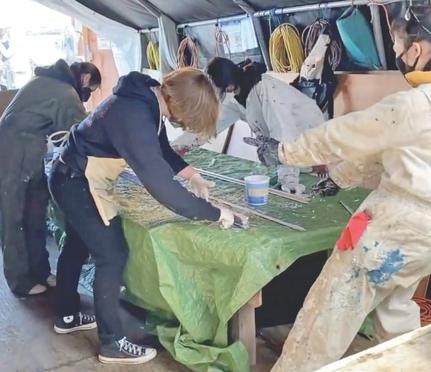
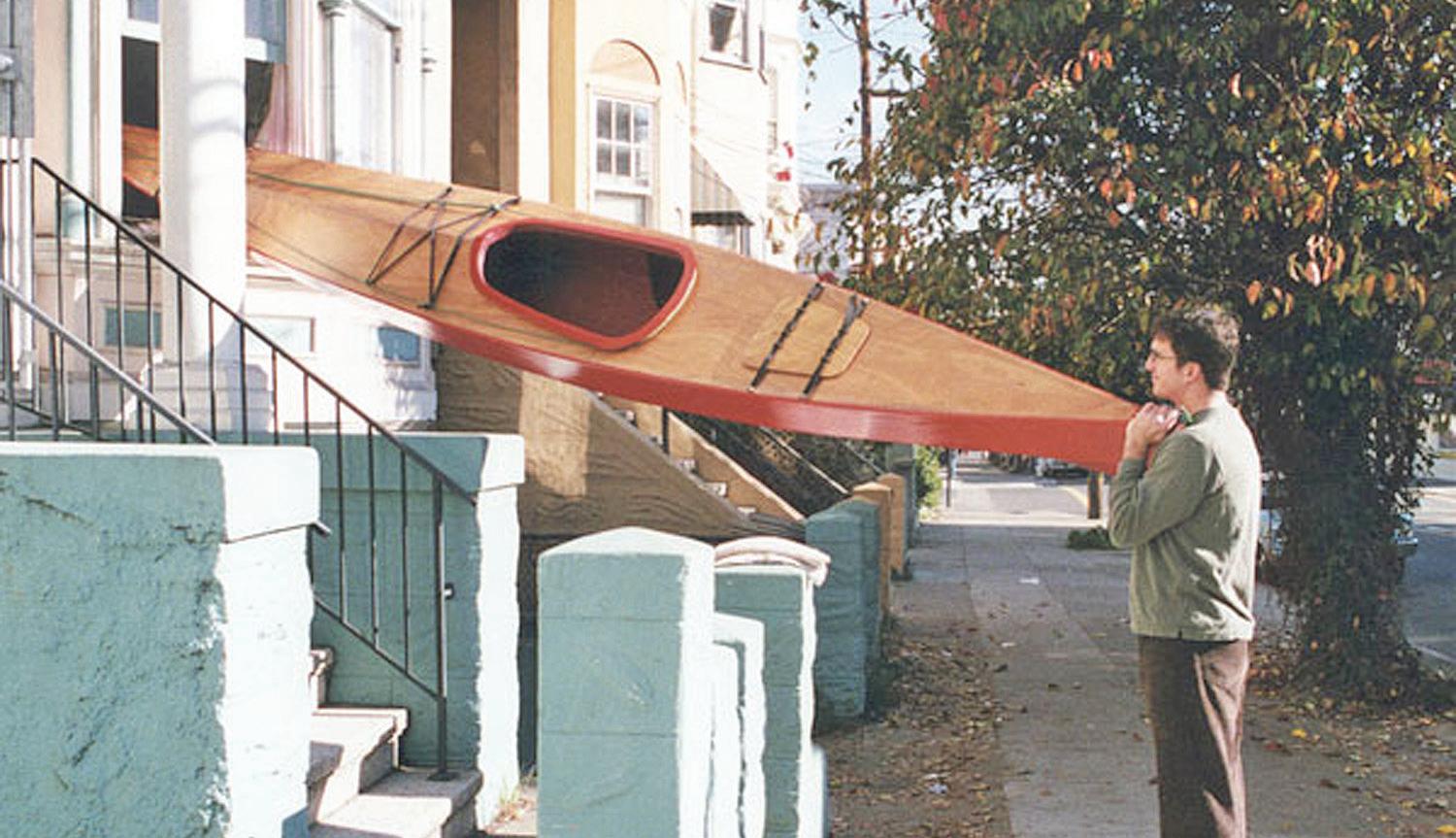
After Bill built a kayak in his apartment, the only way to get it out was through the window.
help of his wife, Kirsten, two sons Ben and Sam, many friends, and his sailor elder brother, Ernie Galvan, "an avid Latitude 38 reader and constant source of encouragement and sailing transfer energy," the boat was finished and ready to launch. COVID provided the time and opportunity. "Last summer, Ernie and I embarked on building spars from old-growth Douglas fir reclaimed from the roof rafters of my 1932 house in Eugene, Oregon. The resulting mast, boom, gaff and tiller should see first use this coming summer."
Although the vessel is yet to be christened, Dennis is considering what he thinks might be an appropriate name, Stolen Pearl. "I checked out the DIY book, pictured, but must confess that, all these years later, I have yet to return it." Although in view of the lessons he has learned throughout the construction, he likes Perseverance as an alternative name. And Dennis's last words on the matter? "I'd like to officially request amnesty from the San Jose Public Library System for the overdue book."
To most people, boat building probably comes across as a job for professionals. They need to have big spaces, big tools and equipment, and big budgets. But more and more we're finding this is not always the case. Captain Heather Richard, owner and operator of the local charter business Fine Day for Sailing, built a boat with her son Julius. "We chose to build an Eastport Nesting Pram so that we can easily take it cruising with us on the floor deck of our 43-foot sloop," Heather told us. Together they built the Chesapeake Light Craft (CLC) boat during quarantine, working on average three days a week over three months. "My son, who is 14, found parts of the project really difficult and other parts really satisfying. It was a lot more work than he maybe anticipated, but also the end result was a lot more satisfying. "If you don't have a shop for anything more than just hand tools, this stitchand-glue type of construction is an awesome way to get a really great boat, as long as you have a small space to set up a couple of sawhorses and work uninterrupted. Having a dedicated space where we could leave it and come back and work on it anytime was key to getting it done, so I had to say 'thank you' to my parents for allowing us to take over their backyard during quarantine to build this boat!" Heather believes building the boat was worth the time and effort. "I think the end result was nice to have, but actually the time spent alone with my son doing something for him is something even more valuable than the boat. "I think he enjoyed learning how to use tools and epoxy and decided to customize it a little bit with carbon-fiber cloth on the bottom so he could drag it up onto a rocky beach without it being too heavy, but strong enough to take a bit of a beating. I think he feels quite proud when people say, 'Wow, you built that?'"
Heather would do it all again and says what she has learned would help the next build "go more smoothly." "I have a feeling Julius might also be interested in either designing or building his own boat again in the future, but for now he's just enjoying taking it out for fun with his friends and using it." And regarding the building style, Heather says, "I definitely would recommend the stitch-and-glue method for anyone who is starting their first boat-building project."
Despite the fact that it is possible to
DENNIS GALVAN
Dennis Galvan's notes look as old as the book he filched.
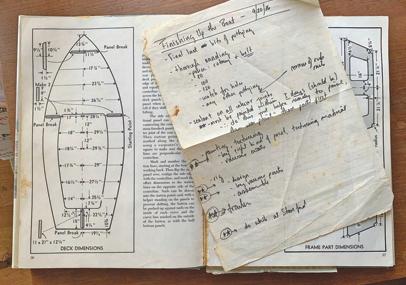
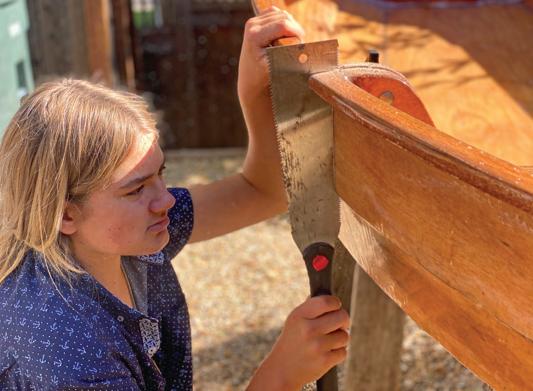
BOTH PHOTOS HEATHER RICHARD

Left: It must be terrifying to cut your boat in half after having built it. Right: But it's worth it in the end. Julius Richard looks very happy with the result.
The Sea Scouts are enjoying using their newfound skills.
build small boats in the garage, shed or backyard, there are people who either don't have these minimal requirements or perhaps lack the interest or confidence to embark upon a build themselves, but still want to try it out. This is where volunteering becomes a good option. Right now, there are opportunities on the Bay for volunteers to help with small-boat builds without having to provide the space or tools themselves. While we've already mentioned the Sea Scouts and their Nutshell Pram, another project is currently underway at Spaulding Marine Center in Sausalito. Here volunteers are building six San Francisco Bay Pelicans — a 12-ft pramstyle sailboat designed in 1959 by Bill Short to suit the Bay's often-windy, choppy conditions. Spaulding's education director Jay Grant says the Pelican suits their purposes for several reasons. "We wanted to get the community involved in something new and interesting. We call it the Pelican Project," Jay
Kirsten Galvan shows how easy it is to build a boat in your backyard.

DENNIS GALVAN laughs. "We thought it would be fun to build our own boats to use for our camp and community sailing programs. Our in-house designer Jeff Lutz spent a considerable number of hours digitizing the plans for CNC cutting, and designing the whole process so that they can be built like a kit, including a cradle that they're built in. "We built a prototype and made a couple of revisions to arrive at this one. And we'll be able to supply this boat in a kit form shortly."
So far, a handful of volunteers have stepped up to help the nonprofit group build the Pelicans, using the same stitch-and-glue method Heather and Julius Richard used for their Eastport Nesting Pram. None of the volunteers are professional builders, but they all share an enthusiasm for helping to get kids out on the water. George Shea, for example, is providing his experience with carpentry and woodworking, while Ralph Szur has volunteered on building programs in New York and participated in the Beacon Sloop Club's three-year restoration of the Hudson River Sloop Woody Guthrie. "There's still room for more volunteers," Jay adds. "It's a great way to learn how to build a boat, and it's a lot of fun, so the more the merrier!"
Frank Schlosser has experienced boat building both as a volunteer and as builder of his own lapstrake dinghy following plans and a small instruction manual. "I wanted to learn how to sail," Frank tells us, "so I built this Herreshoff dinghy in 1980. Pretty much selftaught, but with encouragement from a friend." Incidentally, that was also how he learned to sail.
Frank was clearly encouraged by the result of the Herreshoff and later built a fishing boat for his then 10-year-old son. This one was built from plywood following plans they had found on the internet. He also built a land yacht using plans he bought from Australia. With all that experience behind him, it wasn't surprising to learn that Frank was one of the volunteers for the Matthew Turner, the 132-ft brigantine launched April 1, 2017. In fact, he donated his time consistently over the course of seven years. "I can't remember for sure, but I have over 2,500 hours volunteering on Matthew Turner." Frank says he has enjoyed the experience and what he has gained over
his time working on the enormous ship. "Monday through Friday, I am a cabinetmaker, and when asked if I can build something, I just smile and think, 'After helping build Matthew Turner, cabinetry is a breeze!'"
But back to small boats … of which Bill Quigley has built several. "The first thing you have to do when building a boat inside," he says, "is figure out how you're going to get it out!"
So far the biggest boat Bill has built is a Farrier 32 trimaran, Tatiana. (That's a little bigger than the small boats we've been discussing, but still, he built it
SEA SCOUTS


FRANK SCHLOSSER
Frank Schlosser's Herreshoff dinghy. His first build was a strip canoe.
himself.) He even raced Tatiana in the 2019 Race to Alaska (R2AK). "I like to think I have the all-time R2AK record for home-built boats."
But his favorite build is a two-piece nesting dinghy called the Two-Paw 9, by Graham Byrnes. "It only weighs 45 pounds and stows in 4 feet 8 inches, and tows well at up to 15 knots. All of my boats are from plans, although at this point I usually modify them."
Bill works in the technology field and finds building boats to be a nice contrast to his day job. "I prefer boats to other kinds of woodworking because the finished product is far more usable. I also enjoy solving the innumerable puzzles that come with building a boat, even from well-thought-out plans. "Building a small boat is a lot easier than it seems," he adds. "I encourage any sailor with 10 feet of space to spare to try it. A small plywood dinghy will last far longer and is much more fun to row than an inflatable, and one of the new electric outboards will do a great job pushing it around when you don't feel like rowing." But what does he do with all those home-built boats? "I've sold a few and given a few away, but any boat that remains useful to me stays in the fleet. Every once in a while I have to sell one to make room for something new."
As you can see, there is a lot of boat building going on behind the scenes, in garages, sheds and backyards. Who would have thought that so many people would be interested in building their own little ship? Perhaps it all started with the bathtub boats we all inevitably enjoyed as youngsters, or perhaps it started with the Bay Area's salt air and ever-present wind. Whatever the origin, we feel this is one good thing that has evolved from the pandemic-related lockdowns we've all had to endure. By all accounts, building a boat is challenging, but also fun and rewarding in so many different ways. If you've ever thought about trying it for yourself, hopefully the individual stories we've uncovered have encouraged you to pick up some tools and start building your own small boat, or at the very least volunteer somewhere. Who knows? You might just find a new passion. — latitude/monica
NATE SPENCER-MONK

Nate's new Biscayne Bay 14 is looking very nice.
Master Mariners Wooden Boat Show
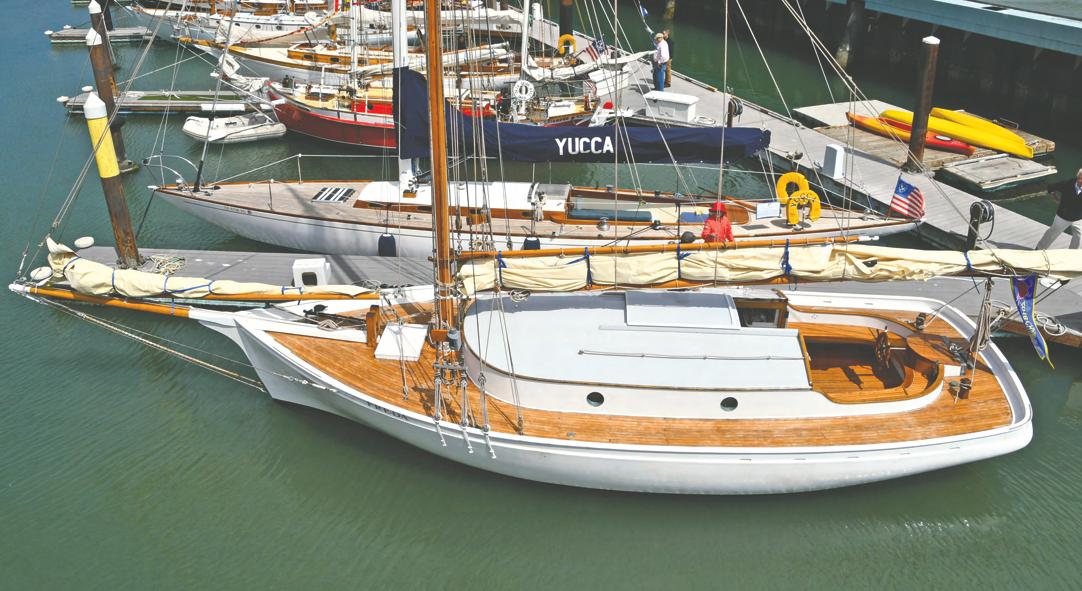
Our Annual Regatta Saturday, May 29
Sunday, June 20 10 a.M. – 4 p.M. Corinthian yaCht CluB
View classic sailing vessels, meet their skippers and learn the yachts' unique history. Show proceeds to go to Master Mariners Benevolent 501(c)3 Foundation. The Foundation provides scholarships for youth sailing, wooden boat building and maritime education. Also provides for the preservation of SF Bay Classic yachts. MMBF is dedicated to preserving the continuity of traditional yachting on San Francisco Bay. The Master Mariners Benevolent Association is dedicated to fostering participation in yachting and the preservation of classic and traditional sailing craft. During the Boat Show, the Corinthian Yacht Club outdoor bar will be open, lunch can be order from the Ala Carte lunch menu, and there there is model boat building for kids. Children under 12 free when accompanied by an adult.







